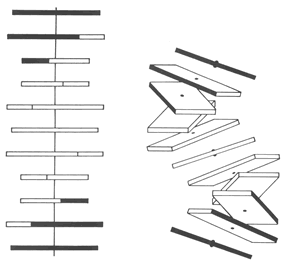
|
|
||||||||

Structural Mechanics in Molecular Biology
Most people are now familiar with the idea that the molecular structure of DNA takes the form of a double helix, as first established by Francis Crick and James Watson in 1953: the base-pairs whose sequence spells out the genetic code are arranged like the treads of a staircase, held between the two spiral "backbones". What is not so well known is that in the laboratory DNA "switches" between two distinct double-helical forms as the moisture content changes. Calladine and Drew were curious why there is a switching action here, rather than a continuous change between the two forms.
 Corresponding
models in which the base-pairs are represented by simple rectangular
blocks, and the helical backbones have been removed. These models
show shorter pieces of DNA at a somewhat larger scale. They enable
us to see how a simple geometric change of stacking at every step
(a 'roll' angle of 12° and a translational 'slide' of 2Å)
correctly reproduces the overall conformational changes seen on the
next page (a shortening, a thickening and a tilting of the base-pairs). Corresponding
models in which the base-pairs are represented by simple rectangular
blocks, and the helical backbones have been removed. These models
show shorter pieces of DNA at a somewhat larger scale. They enable
us to see how a simple geometric change of stacking at every step
(a 'roll' angle of 12° and a translational 'slide' of 2Å)
correctly reproduces the overall conformational changes seen on the
next page (a shortening, a thickening and a tilting of the base-pairs). |
The key to the situation is that the double-helical structure is actually driven by the stacking of base-pairs on top of one another, with the "backbones" merely providing some constraints to the conformation. This "inside-out" view of DNA enables many sequence-dependent mechanical properties of DNA to be understood - such as curvature, stiffness, and modes of distortion upon binding DNA to protein. In their book 'Understanding DNA : the molecule and how it works' Calladine and Drew use the principles of structural engineering to explain many aspects of the physical performance of this complex molecule.
For further information, please contact Professor Chris Calladine - crc@eng.cam.ac.uk.